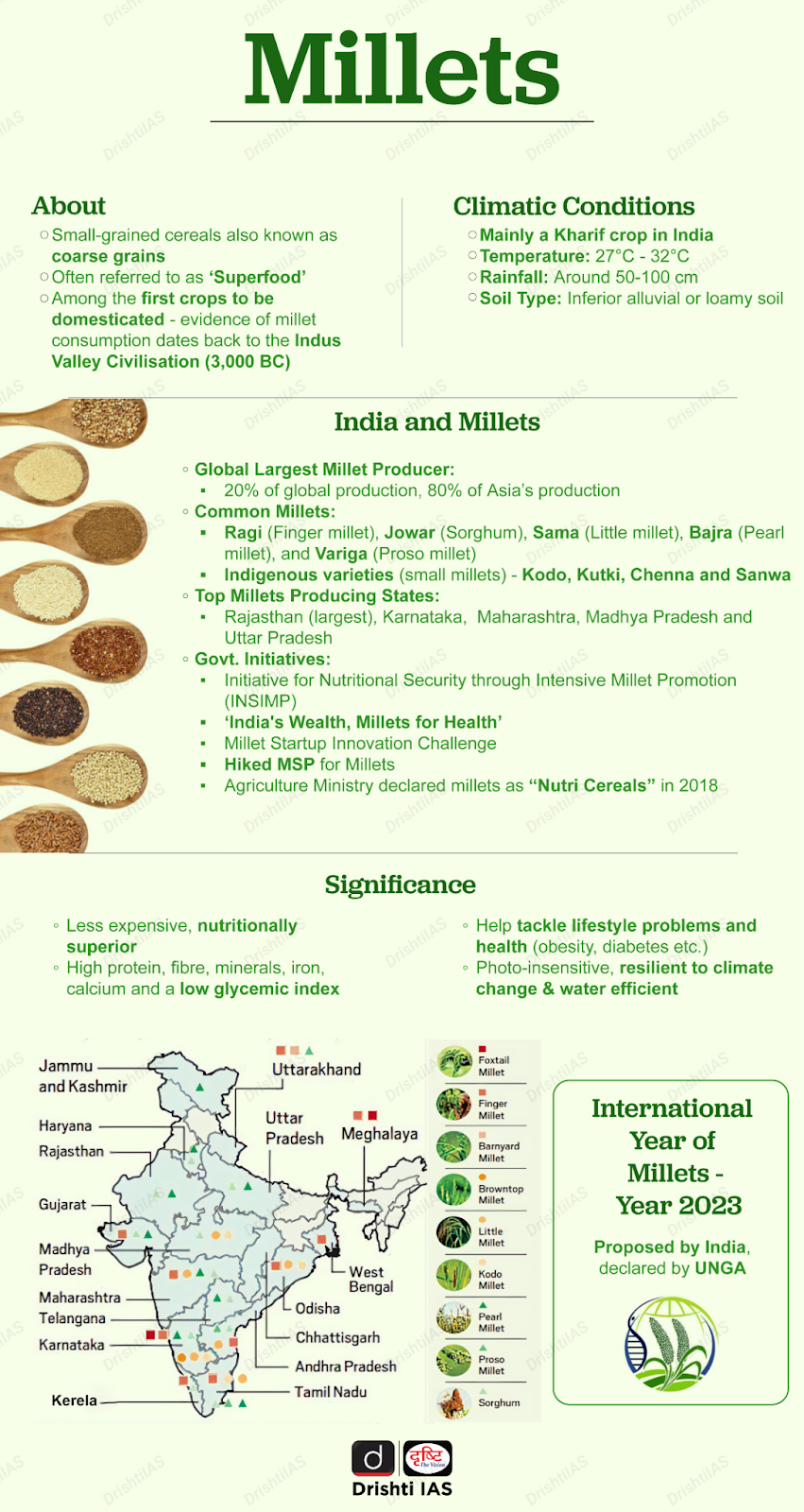Agriculture
Crop Switching for Sustainable Agriculture
- 21 Oct 2023
- 7 min read
For Prelims: Crop Switching, Drip Irrigation, Indo-Gangetic Region, Millets
For Mains: Types of Farming, Cropping Patterns Contribution to Economy, Employment & Output, Food Security
Why in News?
A recent study, featured in the journal Nature Water, was conducted by a team of researchers from the Indian Institute of Technology Bombay, the University of Delaware, Columbia University, and Yale School of the Environment.
- This study focuses on addressing water consumption and sustainable agriculture in India's northern plains, particularly the Indo-Gangetic region.
- The study focused on 124 districts in Uttar Pradesh, Bihar, and West Bengal, covering the upper, middle, and lower Ganga basin in India.
What are the Key Findings from the Study?
- Water Conservation through Crop Switching:
- Replacing rice with millets (pearl millet (bajra) and sorghum) during the Kharif season and shifting from wheat to sorghum in the Rabi season can reduce water consumption in the Indo-Gangetic Plains (IGP) by 32%. And boost farmers’ profits by 140%.
- Beyond Water Conservation:
- Crop switching can improve water savings by 55% in the Kharif season and 9% in the Rabi season.
- Farmers' profits can increase by 139% during the Kharif season and 152% during the Rabi season.
- Calorie production can increase by 39%.
- Crop Switching vs. Drip Irrigation:
- The authors compared the benefits of crop switching vis-a-vis improving irrigation efficiency — from flood to drip irrigation, and found that Crop switching outperforms drip irrigation in reducing groundwater depletion and energy savings.
- Drip irrigation improves net groundwater recharge by 34%, while crop switching achieves a 41% improvement.
- Drip irrigation alone does not enhance calorie production or farmer profits.
- A combination of crop switching and drip irrigation shows the greatest improvement in net recharge at the district level and reduces groundwater depletion by 78%.
- The Multi-Objective Approach:
- A multi-objective approach is essential for achieving a balance between water conservation, increased calorie production, and higher farmer incomes.
- Single-focused approaches come with trade-offs. For instance, prioritizing water conservation alone may boost savings by 4%, but it leads to significant reductions: Calorie production falls by 23%, and Profit drops by 126%, respectively, compared with the proposed solutions.
- Similarly, a profit-maximizing approach may slightly increase water savings but also reduce calorie production.
- Choosing a profit-maximizing strategy centred around sorghum, with its high minimum support price and low cultivation costs, can significantly boost profits by 58%. However, this gain is coupled with a stark trade-off: a notable 18.5% reduction in calorie production, a marginal 2% increase in water savings.
- Nutri Cereals for Improved Nutrition:
- Shifting to Nutri cereals, including sorghum and bajra, offers improved nutrition.
- Nutri cereals can lead to a 46% increase in protein production, a 353% increase in iron production, and an 82% increase in zinc production, benefiting consumers in terms of nutrition.
North Indian Plains
- About:
- They are a large flat landmass that lies south of the Himalayas and north of the Peninsular India.
- They are formed by the alluvial deposits of three major river systems: the Indus, the Ganga, and the Brahmaputra, along with their tributaries.
- They are the largest alluvial tract of the world.
- Geographical Overview:
- The Indo-Gangetic region has a subtropical climate with hot summers and cool winters.
- The northern plains can be divided into four physiographic regions based on the nature of the alluvium and the relief features.
- Bhabar:
- It is a narrow belt of coarse gravel and pebbles along the foothills of the Himalayas. It is about 8 to 16 km wide and has a porous surface that allows water to seep through it.
- Terai:
- It is a marshy and swampy region south of the Bhabar. It is about 20 to 30 km wide and has a rich soil and dense vegetation. It is also home to many wildlife sanctuaries and national parks
- Bhangar:
- It is the older and higher alluvial plain that lies above the flood level of the rivers. It is composed of clay, silt, and sand.
- The soil in this region contains calcareous deposits, locally known as kankar.
- It is the older and higher alluvial plain that lies above the flood level of the rivers. It is composed of clay, silt, and sand.
- Khadar:
- It is the newer and lower alluvial plain that lies along the river banks. It is composed of fine silt and clay. It has a light color and is very fertile. It is renewed every year by the floods.
- Bhabar:
- Agricultural Significance:
- The IGP plays a pivotal role in Indian agriculture, contributing 30% of the country's total food production.
- It serves as a primary source of food, including staple cereals like rice and wheat.
- The IGP plays a pivotal role in Indian agriculture, contributing 30% of the country's total food production.
- Demographic Significance:
- This region is one of the most densely populated areas globally, with an estimated 400 million inhabitants. The population density, especially along the banks of the Ganges, is exceptionally high.
UPSC Civil Services Examination Previous Year Question (PYQ)
Prelims
Q. With reference to ‘Initiative for Nutritional Security through Intensive Millets Promotion’, which of the following statements is/are correct? (2016)
- This initiative aims to demonstrate the improved production and post-harvest technologies, and to demonstrate value addition techniques, in an integrated manner, with a cluster approach.
- Poor, small, marginal and tribal farmers have a larger stake in this scheme.
- An important objective of the scheme is to encourage farmers of commercial crops to shift to millet cultivation by offering them free kits of critical inputs of nutrients and micro irrigation equipment.
Select the correct answer using the code given below:
(a) 1 only
(b) 2 and 3 only
(c) 1 and 2 only
(d) 1, 2 and 3
Ans: C





